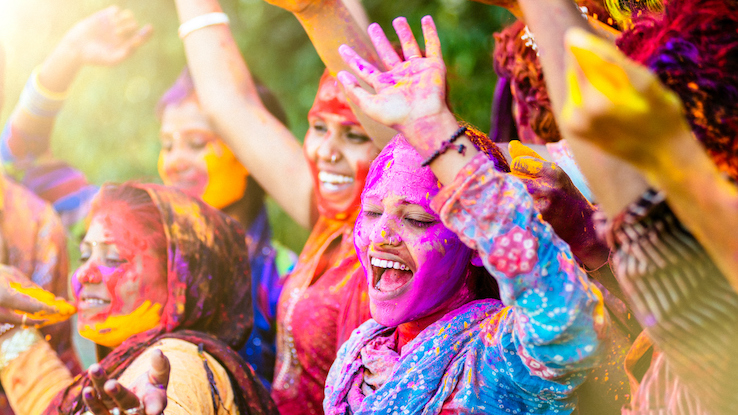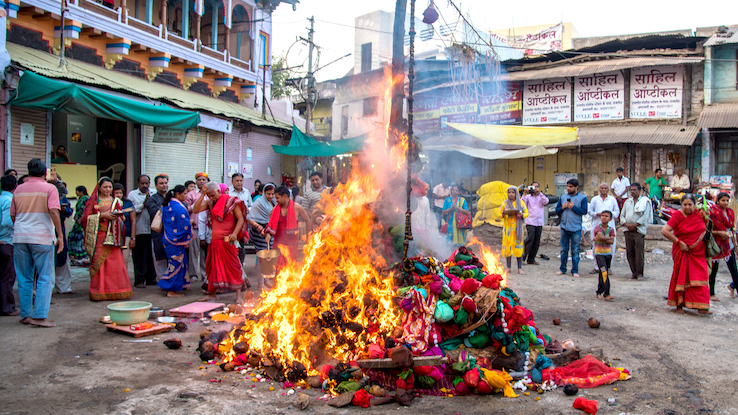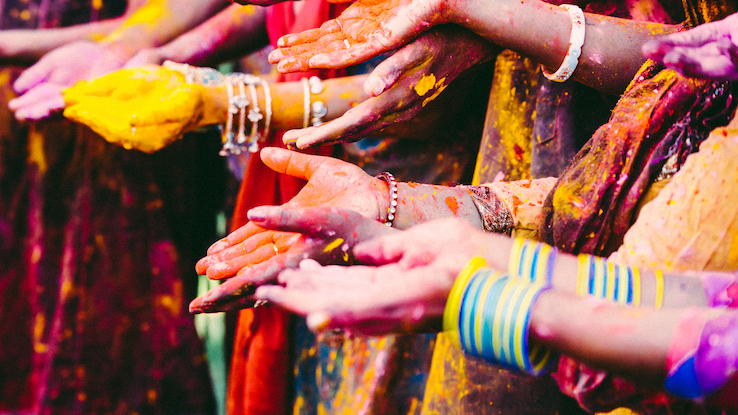Holi: The History of the Hindu Festival of Spring

Each year, the festival of Holi ushers in a vibrant eruption of color as Hindus around the world flood the streets to douse each other in brightly colored powders and dyes. Holi, also known as the Festival of Colors, is an ancient Hindu spring festival that celebrates not only Indian mythology but also love, joy and the victory of positive forces in the world. Join us for a fascinating look at the history of Holi, its significance and the ways people celebrate it today.
What Is the Holi Festival?

Holi is a Hindu festival that celebrates the arrival of spring and the triumph of good over evil. The holiday begins on Holika Dahan, the night before the color festival when many families prepare by lighting bonfires. They then say prayers of cleansing, asking that any evil or dark energies lurking within them be burned away as they place pieces of wood into the fire.
It’s important to note that timing is essential when performing the Holika Dahan bonfire; doing so too early is believed to bring bad fortune. The exact dates of Holi also vary from year to year on the Gregorian calendar because they correspond with the Hindu calendar, which is a bit different.
The day after Holika Dahan, the streets erupt into a huge celebration with food, songs, dancing and, of course, a massive colored-powder and water fight among revelers. Some people even break out water guns or pelt each other with water balloons, but the whole celebration is all in good fun.
As the color celebrations wind to a close, people enjoy food with their friends and family. Traditional Holi foods include deep-fried sweet pastries called gujiya, a buttermilk drink called lassi and fried pancakes called malpua.
Why Do People Celebrate Holi?

While the Holi festival is a beautiful celebration of the coming of spring after the dark days of winter, at its heart is an ancient Hindu legend about the triumph of good over evil. It all began long ago when the demon lord Hiranyakashipu decided to defeat Vishnu, one of the three principal gods of Hinduism’s holy trinity.
While many felt compelled to turn from the gods and begin praying to Hiranyakashipu, the demon lord was enraged to discover that his son, Prahalad, maintained loyalty to Vishnu. So, Hiranyakashipu devised an evil plan to kill his son with the help of his sister, Holika.
Wrapped in a fire-resistant cloak, Holika lured Prahalad onto a funeral pyre, plotting to hold him down until the flames consumed him. However, Holika’s plan went awry when the cloak suddenly leapt from her body and cocooned Prahalad instead. Thus, the virtuous Prahalad was spared, but the evil Holika was incinerated when her plot backfired.
The colors of Holi also relate to a tale of Krishna, an avatar of Vishnu. Legend says that when Krishna was young, he fell in love with a woman named Radha but worried she wouldn’t reciprocate his feelings because his skin was blue. Krishna’s mother suggested he rub some dye on Radha’s face and, long story short, it worked — Radha later became his companion.
The Origins and Evolution of Holi

The origins of Holi are a bit hard to pin down simply because the festival has been celebrated for thousands of years. Mentions of Holi, originally known as Holika, can be found in ancient texts, including the Jaimini Purva Mimamsa-Sutras (ca. 300–200 B.C.).
While Holi is an ancient tradition, some historians believe that, like most things, it evolved a bit over time. It’s believed that the Holi celebrations of today may stem from a rite initially performed by married women who would pray to Raka, the goddess of the full moon, for the well-being of their families.
Today, however, Holi is seen as a great equalizer, as people of all ages and castes throw aside social norms and come together to celebrate. During Holi celebrations, children can spray their elders with water guns, people can pelt each other with water balloons in the street, and the colorful puffs of dye fall on people of all backgrounds. If you’re ever lucky enough to participate in the fun, you’ll likely hear the common phrase “Bura na mano, Holi hai,” which means “don’t be offended, it’s Holi!”
Variations on Local Holi Traditions

Like any other regional holiday, Holi has inspired several local traditions. For instance, in the Indian towns of Barsana and Nandgaon, the festival has taken on the form of “Lathmar Holi” or “Holi with sticks.” Not only do the usual color fights take place, but people go around playfully teasing each other, and the recipients of the teasing are allowed to swat their teasers away with branches.
In the Kumaon region, there’s a tradition known as Khadi Holi. Similar to western Christmas caroling, people dress in traditional clothes on Khadi Holi and travel around singing songs. Meanwhile, in West Bengal, people celebrate Doljatra, which is similar to Holi but emphasizes the legend of Krishna and Radha instead of that of Prahalad and Holika.
There’s even a Sikh festival called Hola Mohalla that follows Holi by one day. During the three-day festival of Hola Mohalla, which means “mock fight,” Sikhs gather to show off their fighting prowess through a series of choreographed battles and martial arts exhibitions. The celebration also includes daredevil-type feats, music and even poetry competitions.





